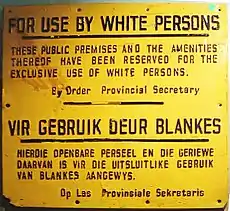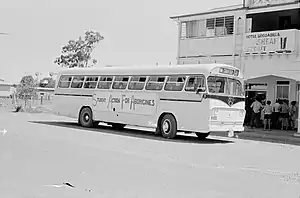Freedom Ride (Australia)
The Freedom Ride of 1965 was a significant event in the history of civil rights for Indigenous Australians.
| Part of a series of articles on |
| Racial segregation |
|---|
 |
| Segregation by region |
|
| Similar practices by region |

Inspired by the Freedom Riders of the American Civil Rights Movement, students from the University of Sydney formed a group called the Student Action for Aborigines, led by Charles Perkins (the first Indigenous Australian to graduate tertiary education) among others, and travelled into New South Wales country towns on what some of them considered a fact-finding mission. What they encountered was de facto segregation; the students protested, picketed, and faced violence, raising the issue of Indigenous rights. They commonly stood protesting for hours at segregated areas such as pools, parks and pubs which raised a mixed reception in the country towns. Australia overwhelmingly passed a 1967 referendum removing discriminatory sections from the Australian Constitution and enabling the federal government to take direct action in Aboriginal affairs.
At the time of the Freedom Ride in 1965, some Aboriginal People of Australia were counted separately in the census[1] and their rights as citizens were regularly ignored. In 1964 a University of Sydney protest against racial segregation in the United States had brought comments from members of the public urging students to look to their own backyard if they wanted to draw attention to racial discrimination.
Participants
The original Freedom Riders were: Charles Perkins, Gary Williams, Aidan Foy, Alan Outhred, Alex Mills, Ann Curthoys, Barry Corr, Beth Hansen, Bob Gallagher, Brian Aarons, Chris Page, Colin Bradford, Darce Cassidy, David Pepper, Derek Molloy, Hall Greenland, Helen Gray, Jim Spigelman, John Butterworth, John Gowdie, John Powles, Judith Rich, Louise Higham, Machteld Hali, Norm Mackay, Paddy Dawson, Pat Healy, Ray Leppik, Rick Collins, Robyn Iredale, Sue Johnston, Sue Reeves, Warwick Richards and Wendy Golding.[2]
Communities visited

Moree was the site of a violent conflict during the Freedom Ride. After a protest at Walgett, an unidentified driver rammed the bus forcing it off the road. Because cadet reporter Bruce Maxwell had come along, the incident made headlines in the Sydney Morning Herald, attracting the attention of international media.[3][4] Some reports compared the treatment of Aboriginal Australians to the racism and segregation in the Deep South of the United States.[5]
The first two towns they went to were Wellington and Gulargambone. Protests were not conducted there. Instead the locals were asked questions which affirmed perceptions of how bad discrimination against Indigenous Australians was in rural areas.[6] Other towns that were visited include Lismore, Bowraville, Dubbo and Kempsey.
2005 re-enactment
In 2005 another ride travelled through New South Wales. The aim was to determine how much had changed in 40 years and foster debate on reconciliation.[7] Although the 2005 event focussed on reconciliation, experiences of discrimination were reported and the poor housing conditions for some Aboriginal People were noted. The Minister for Aboriginal Affairs Andrew Refshauge was presented with the findings of the 2005 ride which visited more than 13 communities.[7]
2015 50th anniversary
To mark the 50th anniversary of the Freedom Ride, two coaches re-ran the route with several of the original participants and a group of present-day University of Sydney students. This was featured in an episode of the SBS programme Living Black.[8]
See also
- Racism in Australia
- Moree Baths and Swimming Pool, the Freedom Ride resulted in Aboriginal children having full access to the town's swimming pool
References
- Year Book Australia, 1960, Australian Bureau of Statistics, pages 327–328.
- Curthoys, Ann (2002). Freedom ride : a freedom rider remembers. Allen and Unwin. ISBN 1-86448-922-7.
- Curthoys, Ann Endnotes to the book Archived 2011-06-06 at the Wayback Machine March 2003
- Maxwell, Bruce. "Following the Freedom Riders", Sydney Morning Herald 16 June 1965
- Lewis, Daniel (5 February 2005). "Freedom Ride inspires a new generation". Sydney Morning Herald. Retrieved 18 February 2008.
- Dawkins, Kezia (1 February 2004). "Didj "u" Know - Stories: Freedom Ride". Retrieved 18 February 2008.
- "A new generation take the freedom ride 2005". Aboriginal Affairs New South Wales. Archived from the original on 2 April 2011. Retrieved 5 May 2011.
- "Living Black S2015 Ep2 – Freedom Rides". SBS. 23 April 2015. Retrieved 1 September 2015.
External links
| Wikimedia Commons has media related to Freedom Ride (Australia). |
